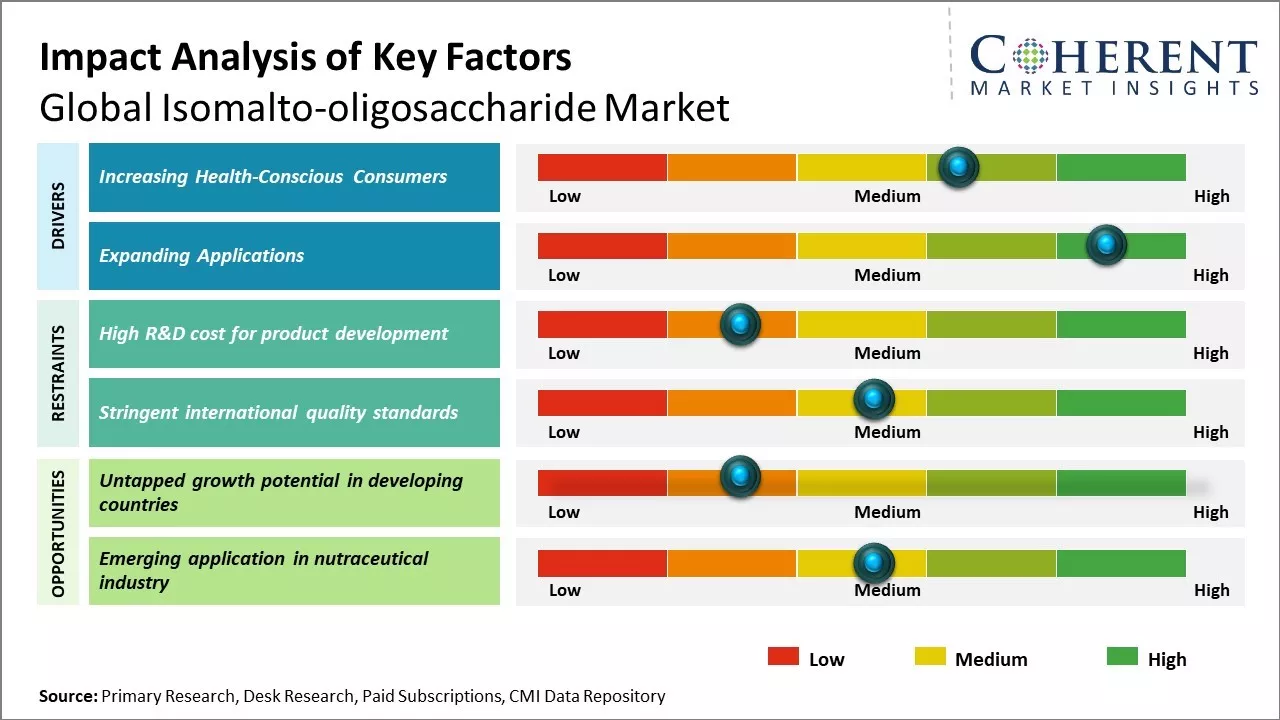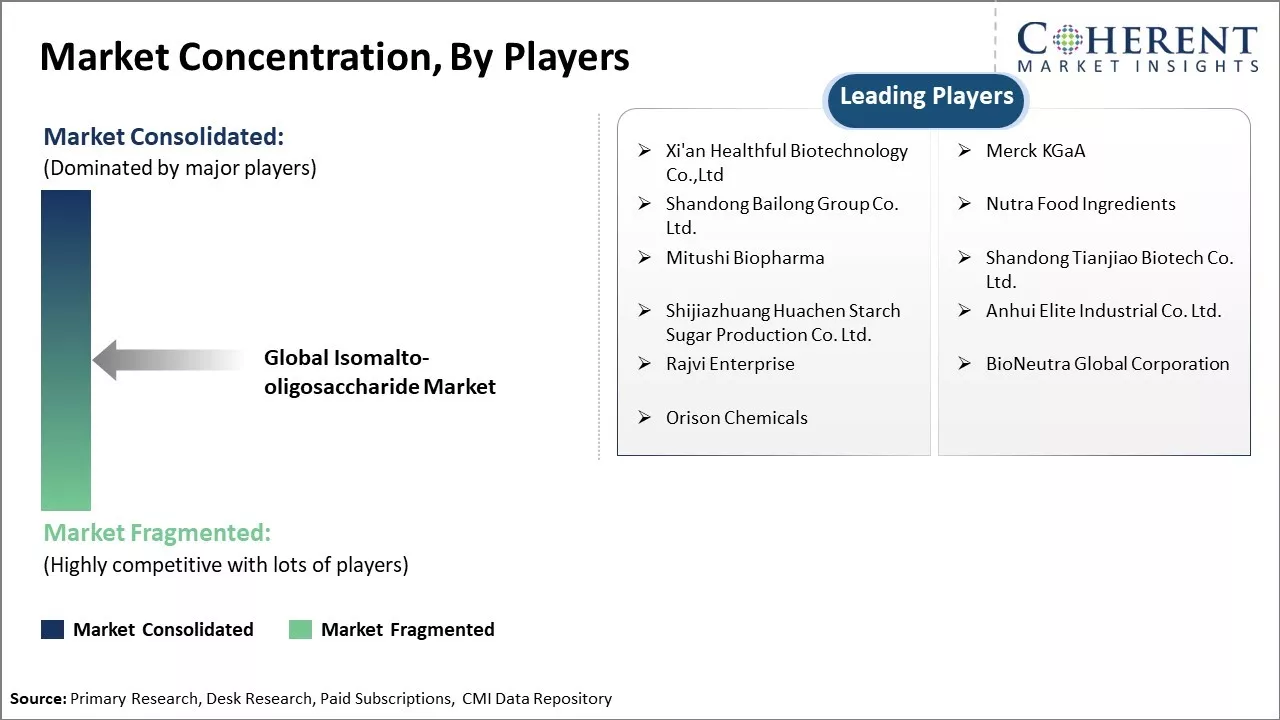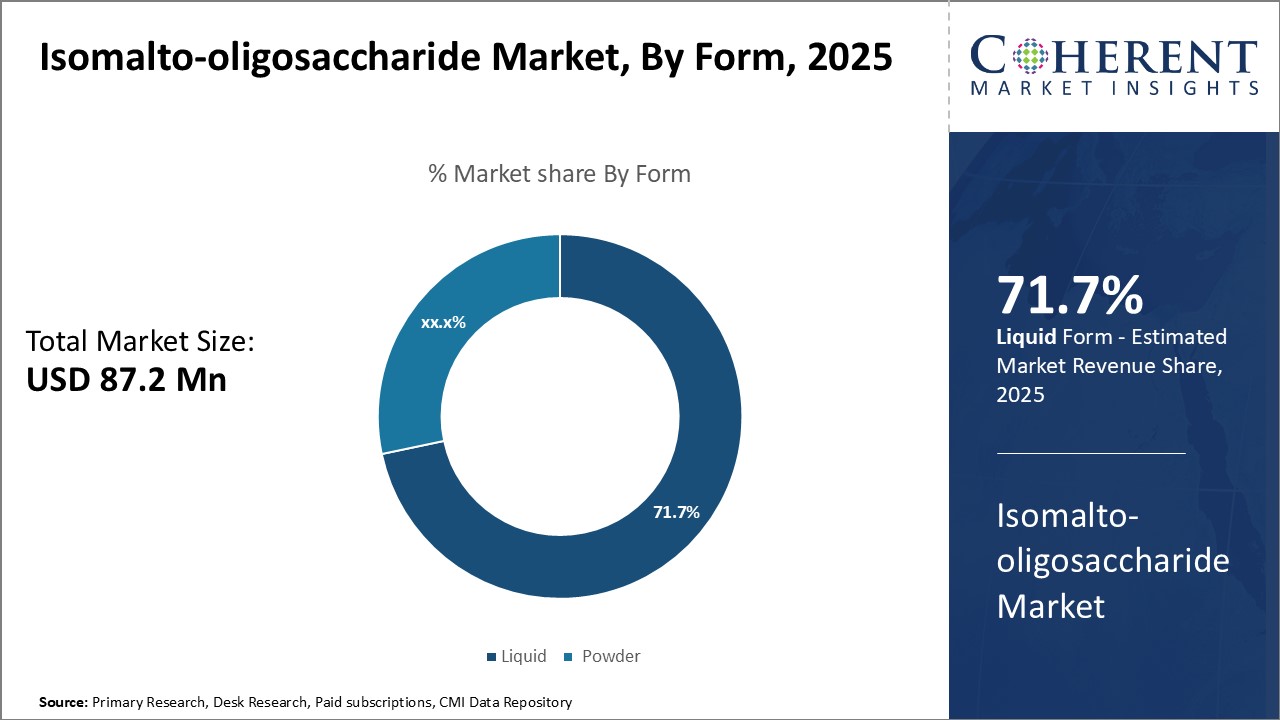Isomalto-oligosaccharide Market Size and Trends
The isomalto-oligosaccharide market is estimated to be valued at USD 87.2 Mn in 2025 and is expected to reach USD 148.6 Mn by 2032, exhibiting a compound annual growth rate (CAGR) of 7.9% from 2025 to 2032.

Discover market dynamics shaping the industry: Download Free Sample
The isomalto-oligosaccharide market is expected to witness substantial growth over the forecast period. The rising awareness about the health benefits of prebiotics and the growing demand for non-digestible and low-calorie sweeteners are expected to drive the demand for isomalto-oligosaccharides. Furthermore, the growing demand for isomalto-oligosaccharides from the food and beverages industry as a sugar substitute and fiber supplement is also expected to support the market growth. Its application in various products such as breakfast cereals, snacks, bakery products, confectionary items, dairy products, etc. is anticipated to provide several lucrative opportunities for the key players in the market during the forecast period.
Increasing Health-conscious Consumers
With rising health awareness, people are increasingly shifting towards high-nutrition prebiotic foods and supplements. Consumers are more informed about the role of gut health in overall wellbeing. Probiotics and prebiotics are gaining massive popularity as people recognize their health benefits. Isomalto-oligosaccharide is a highly effective prebiotic that selectively feeds beneficial bacteria in the gut. It can help maintain a balanced intestinal microbiota and support digestive health. Due to its favorable properties, isomalto-oligosaccharide is being widely used in various food and beverage products. Many new launches in the market emphasize on the prebiotic credentials of isomalto-oligosaccharide. Research has shown positive effects of isomalto-oligosaccharide intake on weight management, boosting immunity, reducing inflammation and lowering risks of various chronic diseases. The market is witnessing various new product introductions touting the prebiotic benefits. Especially in cereal bars, yogurts, juices, and baked goods categories, prebiotic positioning has become crucial. Manufacturers are keen to highlight functional claims to attract increasingly health-savvy buyers. Consumption of prebiotic supplements and fortified foods is growing significantly. The rising demand for immunity-boosting and digestive-health centered products acts as a major driver for isomalto-oligosaccharide market. Its clean label status further reinforces its appeal among modern consumers.
Market Concentration and Competitive Landscape

Get actionable strategies to beat competition: Download Free Sample
Expanding ApplicationsIsomalto-oligosaccharide has been gaining widespread recognition due to its versatile functionality and clean label image. Being a fiber-derived sugar, it can be utilized across diverse food types without affecting the taste or texture. This multi-purpose applicability has opened up new formulation possibilities. Convenient formats like powders, granules, and syrups are giving product developers varied options to enrich foods and enhance nutritional value. The ability to modify rheological properties without being bulky makes isomalto-oligosaccharide very appealing for beverages as well. Besides traditional dairy and bakery categories, applications are expanding into snacks, nutrition bars, breakfast cereals, medical foods, and clinical nutrition products. Sports supplements are a promising new segment due to its enhanced endurance benefits.
Key Takeaways of Analyst:
The global isomalto-oligosaccharide market is expected to experience steady growth over the forecast period driven by the increasing health consciousness among consumers and growing awareness about prebiotic dietary fibers. The demand is primarily fueled by the food and beverage industry where IMOs find wide application in yogurt, baked goods, cereals, and nutrition bars due to their sweet taste and easy digestibility.
Asia Pacific dominates the current demand landscape owing to rising disposable incomes, growing elderly population, and shift toward preventive healthcare in countries like China, India, and Japan. The market in North America and Western Europe is also growing at a notable pace backed by expanding probiotic and digestive health product ranges.
High price point of IMOs compared to other fibers is a major restraint to higher mass adoption at this stage. Manufacturers face challenges related to the lack of consumer education about prebiotics. Rising competition from alternative fibers including GOS and FOS could also limit the market potential. Nonetheless, ongoing R&D toward developing cost-effective production technologies and clinically supporting wider range of health benefits will help alleviate constraints in future. Growth opportunities lie in advancing applications beyond food into pharmaceutical and nutraceutical products catering to digestive disorders and gut health issues.
Market Challenges: High R&D cost for product development
High research and development costs involved in product development have significantly restrained the growth of the global Isomalto-oligosaccharide market in recent years. Developing new Isomalto-oligosaccharide products requires extensive research to understand the complex structure and properties of these prebiotic fibers. It also needs considerable investment in setting up R&D facilities with advanced analytical equipment and hiring highly skilled scientists and researchers. The developmental process from laboratory testing to commercial production is highly resource intensive and time-consuming. Given the relatively small size of the overall Isomalto-oligosaccharide market currently, investments in R&D pose high risks for companies. Most firms lack the financial capabilities and risk appetite to sink large funds into uncertain product development projects. Significant capital is required to thoroughly test new formulations for safety, efficacy, and stability over long durations as part of clinical trials. Any failures or delays in this multi-stage approval process lead to losses running into millions of dollars. This deters many small and mid-sized players from aggressively pursuing innovation.
Market Opportunities: Untapped growth potential in developing countries
Untapped growth potential in developing countries could provide significant opportunities for growth in the global Isomalto-oligosaccharide market. Developing nations across Asia Pacific, Latin America, Africa and parts of Eastern Europe are experiencing rapid economic development and rising disposable incomes. As living standards increase, consumption patterns and preferences are evolving quickly in these emerging markets. There is a growing health and wellness consciousness among consumers, who are increasingly demanding food and beverage products that offer functional benefits like digestive health and prebiotic properties. Isomalto-oligosaccharide, commonly known as IMO, is a prebiotic fiber derived from pancreatic digestion-resistant carbohydrates that promotes the growth of healthy gut bacteria. It is gaining widespread acceptance as a sugar substitute and dietary fiber ingredient globally. The fast-expanding food processing industry catering to burgeoning middle-class populations in developing countries presents a large addressable market for IMO ingredients. Food companies are actively developing products featuring prebiotic labels and marketing their digestive health benefits. This provides opportunities for IMO manufacturers to promote their portfolio of specialty sugars.

Discover high revenue pocket segments and roadmap to it: Download Free Sample
Insights, by Form: Convenience is driving the liquid form’s shareIn terms of form, liquid is expected to contribute 71.7% share of the market in 2025, owing to its convenience of use. The liquid form of isomalto-oligosaccharide provides an easy to consume option for customers. It can be directly added to drinks, smoothies, or other beverages for gut health benefits. The convenience of just pouring the liquid and consuming it makes it favorable compared to other forms. Customers prefer the liquid form as they can easily carry and consume it on the go without any hassle of mixing powder or particulate form. Many athletes and fitness enthusiasts prefer the liquid form as they can add it to their protein shakes and supplements more easily while traveling or training outdoors. Product manufacturers are also focusing on developing more liquid form offerings as they see higher demand and sales potential for convenient formats. The easy mixability and solubility qualities of liquid isomalto-oligosaccharide also make it a preferred choice for product developers to integrate it into various medical foods, infant formulas, and supplement formulations.
Insights, by Source: Abundant source and processing advantage drives the corn segment
In terms of source, corn is expected to contribute 36.9% share of the market in 2025, owing to its abundance and processing advantages. Corn is one of the most widely cultivated crops globally and a major source of carbohydrates. This makes it readily available in large volumes for commercial production of isomalto-oligosaccharide. Corn also contains high levels of starch which acts as the best raw material for enzymatic conversion into isomalto-oligosaccharide through advanced processing methods. The starch structure within corn allows for high yields during enzymatic hydrolysis leading to more economical production. Further, corn starch offers advantages over other sources as it does not require any pre-treatment steps like milling or refining, saving on upstream processing costs. Major producers have also optimized corn-based production processes that deliver high purity and quality standards of the end product. This makes corn a preferred choice for large-scale manufacturing of isomalto-oligosaccharide on a commercial level.
Insights by Application: Multi-dimensional utility drives the functional food segment
In terms of application, functional food is expected to contribute 38.1% of the market share in 2025 owing to its multi-dimensional utility. Isomalto-oligosaccharide provides several health benefits when included in regular diet as a prebiotic fiber that modulates gut microbiota. This unique set of functional properties allows its use in various types of functional foods. It is commonly incorporated into breads, cereals, snacks, and meals to fortify them with prebiotic benefits. Products like prebiotic biscuits, cereal bars, and enriched pasta contain isomalto-oligosaccharide. It is also utilized in yogurts, fermented drinks, and other probiotic formulations to boost their synergistic prebiotic-probiotic effect. Its clean taste and label-friendly nature suit inclusion across diverse functional food categories. Manufacturers are continuously launching new product lines fortified with isomalto-oligosaccharide to meet the consumer demand for nutrition, gut, and digestive health benefits through regular diet. Versatile applications in major health and wellness-oriented food categories drive the higher uptake of isomalto-oligosaccharide in the functional food application segment.
Regional Insights

Need a Different Region or Segment? Download Free Sample
North America continues to dominate the global isomalto-oligosaccharide market. The region is expected to account for 38.0% of the market share in 2025, led by the large health-conscious population and well-established food and beverage industry in the region. Countries like the U.S. and Canada have emerged as major consumers of prebiotic ingredients including isomalto-oligosaccharide. The presence of major players in these countries along with supportive labeling regulations have boosted the adoption of isomalto-oligosaccharide in various product categories over the years. Companies are extensively marketing the benefits of isomalto-oligosaccharide in digestive and gut health which is resonating well with customers here. Furthermore, the regional industry is supported through strong distribution channels that ensure seamless supply to both domestic players and markets in other regions.
The Asia Pacific region, on the other hand, is witnessing the fastest growth and emerging as the new hotspot for isomalto-oligosaccharide manufacturers and suppliers. China and India in particular are displaying high demand dynamics on the back of rising health issues and shifting preferences towards functional foods. Rising disposable incomes have also augmented the demand from the consumer side. Local players in these markets are proactively launching products containing isomalto-oligosaccharide and promoting its various health attributes through aggressive marketing campaigns. Additionally, several international brands are entering into partnership with regional companies to establish local manufacturing units and benefit from the availability of relatively cheaper labor and resource costs. This is allowing imported as well as domestically produced isomalto-oligosaccharide to be highly competitive from a pricing standpoint. The growing industry presence along with innovations catering to regional tastes are propelling the Asia Pacific isomalto-oligosaccharide market ahead of others.
Market Report Scope
Isomalto-oligosaccharide Market Report Coverage
| Report Coverage | Details | ||
|---|---|---|---|
| Base Year: | 2024 | Market Size in 2025: | USD 87.2 Mn |
| Historical Data for: | 2020 To 2024 | Forecast Period: | 2025 To 2032 |
| Forecast Period 2025 to 2032 CAGR: | 7.9% | 2032 Value Projection: | USD 148.6 Mn |
| Geographies covered: |
|
||
| Segments covered: |
|
||
| Companies covered: |
Xi'an Healthful Biotechnology Co.,Ltd , Merck KGaA, Shandong Bailong Group Co. Ltd., Nutra Food Ingredients, Mitushi Biopharma, Shandong Tianjiao Biotech Co. Ltd., Shijiazhuang Huachen Starch Sugar Production Co. Ltd., Anhui Elite Industrial Co. Ltd., Rajvi Enterprise, BioNeutra Global Corporation, and Orison Chemicals |
||
| Growth Drivers: |
|
||
| Restraints & Challenges: |
|
||
Uncover macros and micros vetted on 75+ parameters: Get instant access to report
Isomalto-oligosaccharide Industry News
- In January 2024, SmartSweets, a low-sugar candy brand, used non-GMO IMO as the first ingredient in its products. IMO is a processed food derived from a starch source that reduces calories and results in a high-fiber carbohydrate.
- In 2021, Nagase & Co., Ltd. released Lissenare, a new ingredient made from natural isomalto-oligosaccharides (IMOs) for hair care and styling products
- In 2021, PureFit Nutrition Bars added IMO to its 20th Anniversary protein bars to lower the sugar content while maintaining taste and performance. IMO is a sweet-tasting prebiotic fiber that has essentially zero effect on blood sugar.
*Definition: The isomalto-oligosaccharide market consists of the production, distribution, and sales of isomalto-oligosaccharides. Isomalto-oligosaccharides are low-calorie sweeteners derived from starch that have a slight sweetness and are not fully digested or absorbed in the small intestine of healthy individuals. They are used as fiber supplements and in various food products like biscuits, cereals, snacks, dairy products, and dietary supplements to add fiber content and reduce calories.
Market Segmentation
- Form Insights (Revenue, USD Mn, 2020 - 2032)
- Liquid
- Powder
- Source Insights (Revenue, USD Mn, 2020 - 2032)
- Corn
- Wheat
- Potato
- Tapioca
- Others (Oats, Rice, etc.)
- Application Insights (Revenue, USD Mn, 2020 - 2032)
- Functional Food
- Dairy Products
- Infant Formula
- Dietary Supplements
- Sports Nutrition
- General Well-Being
- Animal Feed Additives
- Others (Poultry, etc.)
- Regional Insights (Revenue, USD Mn, 2020 - 2032)
- North America
- U.S.
- Canada
- Latin America
- Brazil
- Argentina
- Mexico
- Rest of Latin America
- Europe
- Germany
- U.K.
- Spain
- France
- Italy
- Russia
- Rest of Europe
- Asia Pacific
- China
- India
- Japan
- Australia
- South Korea
- ASEAN
- Rest of Asia Pacific
- Middle East & Africa
- GCC Countries
- Israel
- Rest of Middle East & Africa
- North America
- Key Players Insights
- Xi'an Healthful Biotechnology Co., Ltd
- Merck KGaA
- Shandong Bailong Group Co. Ltd.
- Nutra Food Ingredients
- Mitushi Biopharma
- Shandong Tianjiao Biotech Co. Ltd.
- Shijiazhuang Huachen Starch Sugar Production Co. Ltd.
- Anhui Elite Industrial Co. Ltd.
- Rajvi Enterprise
- BioNeutra Global Corporation
- Orison Chemicals
Share
Share
About Author
Yash Doshi is a Senior Management Consultant. He has 12+ years of experience in conducting research and handling consulting projects across verticals in APAC, EMEA, and the Americas.
He brings strong acumen in helping chemical companies navigate complex challenges and identify growth opportunities. He has deep expertise across the chemicals value chain, including commodity, specialty and fine chemicals, plastics and polymers, and petrochemicals. Yash is a sought-after speaker at industry conferences and contributes to various publications on topics related commodity, specialty and fine chemicals, plastics and polymers, and petrochemicals.
Missing comfort of reading report in your local language? Find your preferred language :
Transform your Strategy with Exclusive Trending Reports :
Frequently Asked Questions
EXISTING CLIENTELE
Joining thousands of companies around the world committed to making the Excellent Business Solutions.
View All Our Clients
